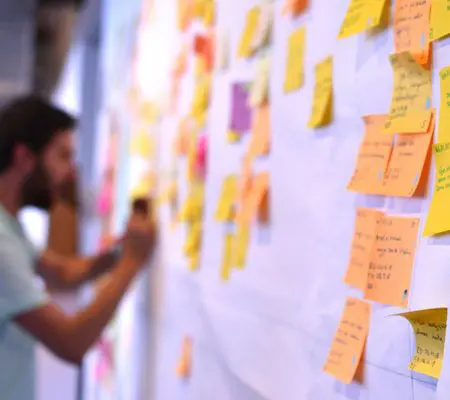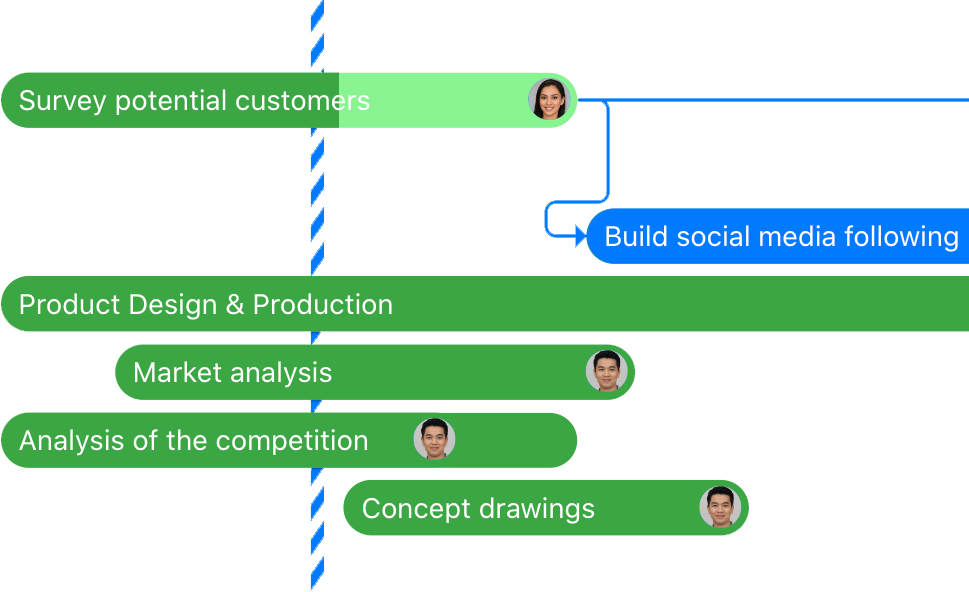How to Design a Project Roadmap That Inspires Your Team
Roadmaps are essential for giving your team and project direction and help project managers make more informed choices.

Whether you are a small business owner, a newly appointed project manager, or a seasoned professional, creating a project roadmap is an essential part of tackling your next initiative. Roadmaps provide focus and clarity, help to set expectations and ensure that everyone is on the same page.
The problem is, not all project roadmaps are created equal. To be effective in achieving your project goals, your roadmap must be well-designed and inspiring to your team.
But what exactly goes into a great project roadmap? And how can you make sure your team is invested in following it? Read on! This article will walk you through the step-by-step process of creating a project roadmap that works.
What Is a Project Roadmap?
A project roadmap is a visual, high-level overview of the major goals and milestones for a project. They can be used for anything from small personal projects to building a SAAS company. And they can be created using a variety of tools, including spreadsheets, project management software, or even just a simple whiteboard.

Project roadmaps are typically used to communicate the project manager’s vision for the project to the rest of the team, and to help keep everyone on track. However, unlike project plans, project roadmaps don’t go into great detail about how the project will be completed.
Instead, project roadmaps focus on what needs to be accomplished and when. This makes them especially useful for communicating with stakeholders who don’t need (or want) to know all the nitty-gritty details.
The Benefits of Project Roadmaps
Both in-person and remote teams can benefit from project roadmaps. While working asynchronously toward a common goal, your project roadmap will help with:
- Coordination: Create a shared understanding of the project that can be used to coordinate efforts across teams and facilitate communication.
- Alignment: Ensure that everyone on the team is working towards the same end goal. This is especially important on large projects with multiple teams working in parallel.
- Focus: Highlight the most important goals and milestones. This helps teams prioritize what’s most essential and avoid getting distracted.
- Visibility: Enable stakeholders, sponsors, management, and team members to see the big picture and track progress.
- Flexibility: Provide a framework that can be easily adjusted as the project, timeline, or goals evolve.
- Accountability: Hold team members and stakeholders accountable for meeting milestones and achieving results.
The Contents of an Effective Project Roadmap
No matter what form your project roadmap takes, there are a few key elements that should always be included:
- Goals: Get clear on your project’s objectives before you start creating a roadmap. What are you trying to achieve, build, or manage? Be specific and realistic so that you can communicate your vision with others.
- Milestones: Work backwards from your desired end-state and break your goals into more manageable sub-tasks. These milestones will help to keep the project moving forward and ensure that everyone knows what needs to be accomplished next.
- Deadlines: In addition to milestones, every goal and sub-task should have a deadline associated with it. This will prevent scope creep and keep the project on schedule.
- Contacts: Include the name, title, and contact information for every involved party. An org chart or simple list format can work well for this. These details will help to route questions or concerns to the right people.
- Resources: Any resources that are necessary for completing the project should be added here. This might include things like budget, content guidelines, or software.
How to Design an Inspiring Project Roadmap
Roadmaps provide clarity about where a project is headed and what needs to be done to get there. This shared vision can be used to inspire and motivate team members. And it can help to ensure that everyone is aligned and working toward a common goal.

But in order to create buy-in and excitement around your project, your roadmap needs to be concise, visually appealing, and easy to understand. So before starting your new software project, follow these 9 key steps to designing an effective roadmap:
1) Select a Format
Before you design your project roadmap, decide how you are going to create it and where it will ultimately be displayed. Here are a few popular formats that you can choose from:
- Spreadsheets: Project roadmaps can be created using spreadsheet software like Excel or Google Sheets. Spreadsheets can be less user-friendly than modern drag-and-drop solutions, but they are free.
- Slide decks: Project roadmaps can also be mocked up using slide-deck software like PowerPoint or Keynote. This can be a good option if you need to present your roadmap to stakeholders, but they are much more difficult to update over time.
- Kanban boards: Digital kanban boards are great for visualizing workflows and tracking progress in real-time. They can be used to dynamically adjust the project roadmap as your team progresses through milestones and priorities evolve.
- Gantt charts: Gantt charts are a type of bar chart that shows how tasks are related to one another over time. They are commonly used in project management and can be helpful for tracking dependencies.
2) Define Your Goals
Project roadmaps require a clear understanding of what you are trying to achieve. Rather than thinking one step ahead, take some time to envision the end-state that you are working towards. What does success look like? What does the finished product or service need to include?
After answering these high-level questions, dig a little deeper and apply the SMART framework. Each goal that you include in your product roadmap should be:
- Specific: Project goals should be simple and well-defined. They should not leave room for misinterpretation or misunderstanding.
- Measurable: Each goal should be quantifiable so that you can track progress and gauge success upon completion.
- Achievable: Strive to set goals that are ambitious yet realistic. Striking the right balance here can be difficult, but it’s important to consider what is actually possible given the resources and time frame that you have to work with.
- Relevant: How does this goal contribute to your overall vision for the project? If it doesn’t align, it might be worth rethinking.
- Time-bound: Project goals should always have a deadline associated with them. These will create natural opportunities to check in with team members, assess progress, and make necessary adjustments along the way.
3) Create Milestones
Once you have a handle on your project goals, separate them into smaller milestones. These will be the specific deliverables that need to be completed in order to move forward.
Again, it’s important to be as specific as possible when creating milestones. Rather than writing “Develop front-end,” try “Design and build out homepage.” This will make it much easier for team members to understand what is expected at each stage.
After outlining all of the necessary microtasks, order them chronologically and group them into phases. Then, estimate how long each task or phase will take and when you expect it to be finished.
Finally, set preliminary deadlines and assign each milestone to the appropriate team or team members. This process will give you an overview of the project timeline which can be helpful for identifying potential risks, dependencies, and resource conflicts.

Maximize your team's efficiency with our project management software.
Sign up for free today!
4) Adjust and Iterate
With the foundation of your project roadmap assembled, take a moment to reflect on what you have created. Does it accurately reflect your goals? Do the milestones make sense in terms of sequence and timing? Are there any potential risks or delays that you haven’t considered?
If so, adjust your roadmap accordingly. Oftentimes, the projected completion date exceeds the amount of time that is actually available. In these cases, it might be necessary to remove or consolidate some of the goals and milestones. Alternatively, you may need to reconsider the project’s resource allocation.
Refining your roadmap is an iterative process and it’s important to be flexible (within reason). Remember that project roadmaps are living documents and no matter how prepared you are, there will always be some degree of uncertainty.
So rather than creating the most efficient and streamlined process possible, plan for disruptions and allow yourself some wiggle room. The goal is to create a roadmap that can adapt to the project.
5) Collaborate with Your Team
Drafting a project roadmap is only the beginning. In order for it to be effective, you need to share it with your team and get their thoughts.
After all, they are the ones who will be responsible for executing the plan and ensuring that everything runs smoothly. As such, they likely have a lot of insights and perspectives to share that can help you fine-tune your roadmap.

So open up the floor for discussion and ask team members questions like:
- Do the goals make sense?
- Are the milestones achievable?
- Do you see any potential risks or conflicts?
- How do you feel about the timeline?
- Is there anything that is missing?
Encourage honest and candid feedback, even if it isn’t what you want to hear. Facilitating open communication may require making additional revisions now, but it can avoid more costly disagreements down the line.
Plus, involving your team in the roadmap creation process also helps to establish buy-in and ownership. When they feel like they have a say in the project, they will be more likely to feel invested in the goals and work diligently to see them through.
6) Share the Roadmap
Now that your roadmap is complete and you have buy-in from your team, it’s time to share it with the rest of the company and any other stakeholders.
Depending on the size of your organization, this could be as simple as sharing the document via email or posting it in a shared folder. If you have a larger company, you might want to create a more formal presentation to discuss the roadmap in person.
Regardless of how you choose to share it, make sure that the roadmap is easily accessible to those who need it on an ongoing basis. This will make it much simpler for heavily involved parties to refer back to it and update it as the project progresses.
This is one of the many reasons that digital, “multi-player” roadmaps are so popular. Offline project roadmaps (like Excel or Powerpoint) only allow one person to work on the document at a time and then have to be re-shared every time there is an update.
With a digital roadmap, on the other hand, everyone involved in the project can access the same live document and make real-time changes as they complete assignments.
7) Update the Roadmap Regularly
As the project moves forward, it’s important to keep the roadmap up-to-date. This means adding new tasks, reassigning deadlines, and removing any completed milestones.
Not only does this help to ensure that everyone is on the same page, but it also allows you to track your team’s progress and identify any potential issues early on. For example, if you notice that a task is taking longer than expected, you may need to remove or consolidate upcoming milestones to meet the final deadline.
Alternatively, you may need to reconsider the project’s timeline and push back the end date. By making these changes in a timely manner, you can avoid any major disruptions or surprises down the line.
8) Celebrate Successes
Achieving milestones is a big deal and should be celebrated as such. This not only helps to keep morale high but also serves as a reminder that the project is progressing as planned.

Recognizing these successes also helps to keep everyone focused and motivated to continue working hard. When team members see the fruits of their labour being acknowledged and celebrated, they are more likely to stay engaged and invested in the project.
So take the time to recognize your team’s accomplishments, no matter how big or small. This could be as simple as sending out an email congratulating them on a job well done or taking everyone out for lunch to celebrate a major milestone. Whatever you do, make sure that your team knows that their hard work is appreciated.
9) Learn from Your Mistakes
No project is perfect, and there will inevitably be some bumps along the road. But that’s okay! These challenges provide an opportunity to learn and grow as a team.
When something goes wrong, take the time to sit down with your team and figure out what caused the issue and how it can be avoided in the future. This might mean making changes to the way you work or adding new processes to the project roadmap.
Whatever the case may be, use these hiccups to improve your project management skills and make your team even stronger. Even if it sets you back in the current project, these learning experiences will pay off in the long run.
Final Thoughts
Designing a project roadmap may seem like a daunting task, but it doesn’t have to be. By following these 9 simple steps, you can create a roadmap that will inspire your team to come together and achieve your most ambitious project goals.
But remember, project roadmaps are not an exact science. You are looking for the right balance of structured yet flexible, and ambitious yet realistic. It takes experience to find this sweet spot, so don’t be afraid to experiment until you find what works for you and your team. With a little trial and error, you will be leading your team to success in no time.
About the Author: Daniel Anderson is a marketing expert who writes about entrepreneurship, business, and personal finance. Learn how to launch a business, scale your team, and plan for financial freedom with step-by-step guides at TheMoneyManiac.com.
FREE 20 MIN. CONSULTATION WITH A PROJECT MANAGEMENT EXPERT
Wanna see how to simplify your workflow with Zenkit in less than a day?
Book a Live Demo